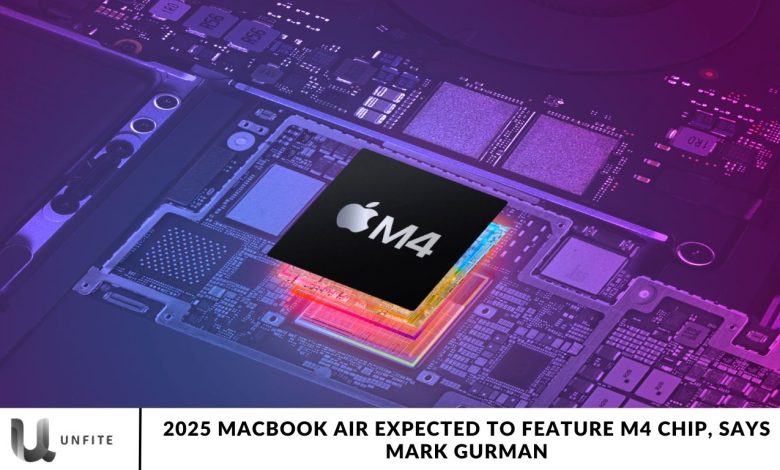2025 MacBook Air Expected to Feature M4 Chip, Says Mark Gurman

Many Apple fans are eagerly awaiting the release of the new MacBook Air, and we have fantastic news! Recently, Bloomberg journalist Mark Gurman announced that the MacBook Air featuring the M4 chip will launch in 2025. This upgraded model is expected to deliver improved performance and enhanced artificial intelligence (AI) features, although it is likely to retain a similar design to the current models.
If you’re waiting for the latest MacBook Air, your patience will pay off soon. The new model is anticipated to resemble the design of the 2022 version. Let’s explore what we can expect from the upcoming MacBook Air in more detail!
Mark Gurman announced the MacBook Air will come with an M4 chip in 2025
Reports suggest that Apple is gearing up to release a new version of the MacBook Air next year featuring the highly anticipated M4 chip.
This upcoming model is expected to deliver robust performance and enhanced artificial intelligence (AI) capabilities. However, the design of the MacBook Air appears to closely resemble that of the current models, meaning there won’t be any significant changes in its aesthetics.
What did Mark Gurman say about the New MacBook Air?
Since the introduction of the M1 chip, Apple has consistently upgraded its proprietary silicon. Following the launch of the M2 chip last year, expectations are high for the upcoming M3 chip, set to debut by the end of this year.
However, according to leaks and rumors, Apple may bypass the M3 altogether and focus on the M4 chip, which is anticipated to be unveiled by late 2024.
The M4 chip is expected to utilize a 5nm or 3nm manufacturing process, which will result in improved speed and energy efficiency.
Mark Gurman reports that the M4 chip will be specifically designed for artificial intelligence. It could feature a more powerful neural engine with additional cores compared to the current 16-core neural engine found in the M3 chip.
This advancement is likely to significantly enhance performance in photo and video editing and improve the execution of machine learning applications and other AI-driven tasks.
MacBook Air’s M4 chip will emphasize AI.

The MacBook Air is expected to include a variety of new AI features powered by the M4 chip. One notable application of AI could be optimizing battery life, as the chip may learn the user’s workflow to manage background applications more effectively, ultimately enhancing energy efficiency.
Additionally, AI could play a significant role in photo editing, offering capabilities like automatic background removal and image enhancement.
There is also speculation that Apple might introduce an intelligent assistant feature in the MacBook Air, enabling users to interact using voice commands.
Although specific details have yet to be revealed, the AI advancements associated with the M4 chip could revolutionize user interaction with the MacBook Air.
MacBook Air’s Design will not change.
If you were anticipating significant design changes, you might feel a bit let down. Mark Gurman reports that Apple is not expected to make any substantial alterations to the design of the MacBook Air, which was last updated in 2022.
This means that the upcoming model will likely feature the same flat-edged design, lightweight build, notch in the display, and Magic Keyboard that have become familiar to users.
It’s believed that Apple operates on a multi-year cycle for design updates. Since the MacBook Air underwent a major redesign in 2022, significant changes are not anticipated for the 2025 model.
These insights are based on Gurman’s reports, and it’s important to note that they remain speculative until Apple officially announces details about the new MacBook Air.
Nonetheless, if these rumors are accurate, the MacBook Air equipped with the M4 chip could offer impressive performance while retaining the slim and stylish design that has made the MacBook series so popular.
M4 Chip – A New Era of Performance
Enhanced Processing Power
The upcoming M4 chip in the 2025 MacBook Air is anticipated to deliver significant performance enhancements compared to its predecessors, the M1 and M2 chips. With improvements in architecture and manufacturing techniques, the M4 is expected to provide faster processing speeds and enhanced efficiency.
Performance Enhancements:
Increased Core Count: The M4 chip is rumored to have a higher number of cores than both the M1 and M2, which will significantly enhance multitasking capabilities and overall system performance. This upgrade will allow users to run multiple applications seamlessly without experiencing lag.
Faster Clock Speeds: With optimized clock speeds, the M4 chip will execute tasks more swiftly, leading to smoother performance in demanding activities such as video rendering, gaming, and coding.
$Comparison with M1 and M2 Chips:
- M1 Chip: Introduced in late 2020, the M1 chip marked Apple’s significant shift to in-house silicon. It provided a remarkable performance boost and efficiency over traditional Intel processors. With an 8-core CPU and an 8-core GPU, the M1 excelled at handling everyday tasks and creative workflows.
- M2 Chip: Launched in mid-2022, the M2 chip enhanced the M1’s capabilities with increased core counts and improved graphics performance. This chip delivered better efficiency in graphics-intensive tasks, making it a suitable choice for professionals in creative fields.
- M4 Chip: In contrast, the M4 chip is expected to surpass both the M1 and M2 with its refined architecture and potential use of a 3nm manufacturing process. This advancement will not only increase processing speed but also improve power efficiency, resulting in extended battery life during demanding tasks.
AI Capabilities
The M4 chip is set to feature advanced artificial intelligence capabilities that will significantly enhance the user experience on the MacBook Air.
AI Technology Integration:
Designed with AI in mind, the M4 chip is expected to include an upgraded neural engine with potentially more cores than the 16-core neural engine found in the current M3 chip. This upgrade will enable the MacBook Air to perform AI-driven tasks more effectively and quickly.
Potential Applications:
- Battery Optimization: One of the most promising applications of AI in the M4 chip is its ability to optimize battery life. By analyzing user behavior and preferences, the chip can intelligently manage background applications and adjust power consumption, leading to extended battery performance throughout the day.
- Photo and Video Editing: Enhanced AI capabilities could also transform creative tasks. Users may benefit from features like automatic background removal, intelligent image enhancement, and real-time editing suggestions. These advancements would simplify workflows for photographers and videographers, enabling them to achieve professional results with less effort.
- Voice Assistants and Smart Features: AI integration may further enhance virtual assistants and smart features within macOS. This would allow users to interact with their devices using natural language commands, creating a more intuitive and user-friendly experience.
Design Expectations for the 2025 MacBook Air
No Major Design Changes
Mark Gurman has indicated that the 2025 MacBook Air will not feature significant design changes compared to the 2022 model. Apple appears to be sticking with the existing flat-edged design, which includes the familiar thin and light body, a notch in the bezel, and the Magic Keyboard.
Insights on Design Continuity:
- According to Gurman, Apple’s decision to maintain the current design suggests that It is satisfied with the 2022 model’s aesthetics and functionality. This continuity reflects a strategic approach to design, allowing the company to focus on enhancing performance and features without altering the device’s external appearance.
- The absence of major redesigns may also imply that Apple follows a multi-year cycle for significant aesthetic changes. With the last substantial update occurring in 2022, the next design overhaul may not happen until later.
Implications of Familiar Design:
- Retaining a familiar design can have several implications. For existing users of the MacBook Air, it ensures a sense of continuity and familiarity, making the transition to the new model feel less daunting.
- Additionally, a consistent design approach may also reduce manufacturing costs and streamline production processes, allowing Apple to allocate resources towards improving internal components and features, such as the new M4 chip.
The Slim and Lightweight Aesthetic
The design of the MacBook Air plays a crucial role in its enduring popularity among consumers and professionals alike.
Importance of Design in Popularity:
- The MacBook Air is renowned for its sleek, slim profile and lightweight build, making it an ideal choice for users who prioritize portability. Whether for students, professionals, or creatives on the go, the lightweight aesthetic enhances mobility without compromising performance.
- Its minimalist design not only looks appealing but also contributes to an ergonomic user experience. The lightweight construction makes it easy to carry in bags or backpacks, making it a favored choice for those who frequently travel or commute.
User-Centric Design Philosophy:
- Apple’s focus on creating a visually appealing and functional design has been a critical factor in the MacBook Air’s success. The integration of high-quality materials and craftsmanship ensures that the device not only looks good but also feels premium in hand.
- This slim and lightweight aesthetic has become synonymous with the MacBook Air brand, appealing to users who appreciate both style and functionality. As such, the continued adherence to this design language will likely contribute to the device’s strong market presence as it evolves with new technology.
Pricing and Market Positioning

Expected Pricing Strategies for the New MacBook Air Models
As Apple prepares to launch its new MacBook Air models featuring the M4 chip, the pricing strategy will play a critical role in attracting consumers and maintaining competitive positioning in the market. The new MacBook Air is anticipated to adopt a pricing structure similar to that of its predecessors, with the base model likely starting at around $999.
This price point has been the standard entry for previous models, making it accessible to a wide range of users. Higher configurations, which may include increased RAM or storage, are expected to see incremental price increases, potentially reaching up to $1,499 for the top-tier models. With the introduction of the M4 chip and enhanced AI capabilities, Apple aims to justify the pricing through significant performance improvements and added features.
This approach positions the MacBook Air as a premium offering in the thin-and-light laptop category, appealing to both professionals and students. Additionally, Apple is known for strategic promotions during peak seasons, such as back-to-school and holiday shopping periods, which could influence overall pricing strategies through discounts or bundle offers.
Comparison with Competitors and Positioning Within Apple’s Lineup
The MacBook Air faces intense competition from brands like Dell, HP, Lenovo, and Microsoft. Notable rivals include the Dell XPS 13, known for its premium design and strong performance, which typically starts around $999, and the HP Spectre x360, a convertible laptop priced similarly at about $1,099. The Microsoft Surface Laptop 5 also competes in this space, with base models starting from $999. Despite this competition, the MacBook Air’s unique integration with Apple’s ecosystem remains a significant advantage.
Features such as Handoff, Universal Clipboard, and seamless iCloud synchronization enhance the user experience, making the MacBook Air a compelling choice for those already invested in Apple’s products. Furthermore, the anticipated AI features and the improved performance of the M4 chip are expected to set the MacBook Air apart, providing functionalities that may not be available in competing models. Within Apple’s product lineup, the MacBook Air is positioned as the most affordable option, catering to users who seek a lightweight laptop without sacrificing performance.
Above the Air, the MacBook Pro offers higher performance and additional features at a higher price point, typically starting around $1,299. This strategic positioning allows the MacBook Air to appeal to a broad audience, effectively balancing performance and price.
Frequently Asked Question
What is the expected release date for the 2025 MacBook Air with the M4 chip?
Answer: The 2025 MacBook Air featuring the M4 chip is anticipated to be released sometime in late 2024, although Apple has not officially confirmed the exact date.
What performance improvements can we expect from the M4 chip?
The M4 chip is expected to offer significant performance enhancements over the M1 and M2 chips, including faster processing speeds, improved graphics performance, and better energy efficiency, making it ideal for demanding tasks and multitasking.
Will the design of the new MacBook Air change with the M4 chip?
According to Mark Gurman, the design of the 2025 MacBook Air is likely to remain similar to the 2022 model, maintaining the familiar flat-edged design, thin and light body, and Magic Keyboard.
What new features will the M4 chip bring to the MacBook Air?
The M4 chip is expected to integrate advanced artificial intelligence features, potentially improving battery optimization, enhancing photo editing capabilities, and possibly introducing smart assistant functionalities.
How does the M4 chip compare to previous chips in terms of AI capabilities?
The M4 chip is designed with a stronger focus on artificial intelligence. It likely features a more powerful neural engine with additional cores compared to the 16-core neural engine found in the M3 chip. This enhancement will significantly speed up tasks involving machine learning and AI.
What will be the expected price range for the 2025 MacBook Air?
The base model of the 2025 MacBook Air with the M4 chip is expected to start around $999, similar to previous models, while higher configurations may range up to $1,499, depending on specifications.
How does the MacBook Air with the M4 chip compare to competitors?
The 2025 MacBook Air is expected to compete well against similar offerings from brands like Dell and HP, mainly due to its integration with the Apple ecosystem, advanced features, and reputation for performance and reliability.
Will the 2025 MacBook Air have better battery life?
Yes, the M4 chip’s capabilities, particularly in optimizing battery management through AI, are expected to enhance battery life, allowing users to work longer without needing a recharge.
Conclusion
The anticipated release of the 2025 MacBook Air featuring the M4 chip represents an exciting development in Apple’s laptop lineup. With Mark Gurman’s insights indicating significant performance enhancements and a focus on artificial intelligence capabilities, users can expect a device that not only maintains the sleek and lightweight design of its predecessors but also delivers improved efficiency and speed. While the design may remain essentially unchanged, the integration of advanced technology promises to enhance everyday usability, particularly in tasks such as photo editing and multitasking.
As Apple continues to innovate and refine its products, the 2025 MacBook Air is poised to attract a diverse range of users, from students to professionals seeking a powerful yet portable laptop. The expected pricing strategy, which remains competitive within the market, further positions the MacBook Air as an appealing choice for those invested in the Apple ecosystem. Overall, the upcoming M4 chip marks a significant step forward for the MacBook Air, setting the stage for an exciting future in portable computing. As we await official announcements and more detailed information, anticipation for this next-generation laptop continues to grow among Apple enthusiasts and tech lovers alike.




